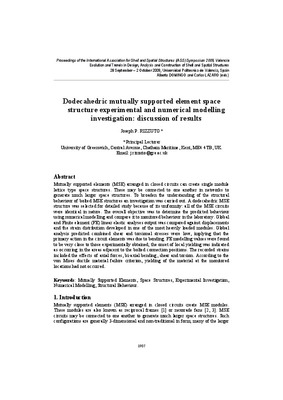JavaScript is disabled for your browser. Some features of this site may not work without it.
Buscar en RiuNet
Listar
Mi cuenta
Estadísticas
Ayuda RiuNet
Admin. UPV
Dodecahedric mutually supported element space structure experimental and numerical modelling investigation: discussion of results
Mostrar el registro sencillo del ítem
Ficheros en el ítem
| dc.contributor.author | RIZZUTO, Joseph P.
|
|
| dc.contributor.editor | Domingo Cabo, Alberto
|
es_ES |
| dc.contributor.editor | Lázaro Fernández, Carlos Manuel
|
es_ES |
| dc.date.accessioned | 2010-02-17T13:29:46Z | |
| dc.date.available | 2010-02-17T13:29:46Z | |
| dc.date.issued | 2010-02-17T13:29:46Z | |
| dc.identifier.isbn | 978-84-8363-461-5 | |
| dc.identifier.uri | http://hdl.handle.net/10251/7163 | |
| dc.description | p. 1907-1917 | en_EN |
| dc.description.abstract | Mutually supported elements (MSE) arranged in closed circuits can create single module lattice type space structures. These may be connected to one another in networks to generate much larger space structures. To broaden the understanding of the structural behaviour of bolted MSE structures an investigation was carried out. A dodecahedric MSE structure was selected for detailed study because of its uniformity: all of the MSE circuits were identical in nature. The overall objective was to determine the predicted behaviour using numerical modelling and compare it to monitored behaviour in the laboratory. Global and Finite element (FE) linear elastic analyses output was compared against displacements and the strain distribution developed in one of the most heavily loaded modules. Global analysis predicted combined shear and torsional stresses were low, implying that the primary action in the circuit elements was due to bending. FE modelling values were found to be very close to those experimentally obtained; the onset of local yielding was indicated as occurring in the areas adjacent to the bolted connection positions. The recorded strains included the effects of axial forces, bi-axial bending, shear and torsion. According to the von Mises ductile material failure criterion, yielding of the material at the monitored locations had not occurred. | en_EN |
| dc.language | Inglés | en_EN |
| dc.publisher | Editorial Universitat Politècnica de València | es_ES |
| dc.relation.ispartof | Symposium of the International Association for Shell and Spatial Structures (50th. 2009. Valencia). Evolution and Trends in Design, Analysis and Construction of Shell and Spatial Structures : Proceedings | en_EN |
| dc.rights | Reserva de todos los derechos | en_EN |
| dc.subject | Mutually supported elements | en_EN |
| dc.subject | Space structures | en_EN |
| dc.subject | Experimental investigation | en_EN |
| dc.subject | Numerical modelling | en_EN |
| dc.subject | Structural behavior | en_EN |
| dc.title | Dodecahedric mutually supported element space structure experimental and numerical modelling investigation: discussion of results | en_EN |
| dc.type | Comunicación en congreso | en_EN |
| dc.rights.accessRights | Abierto | es_ES |
| dc.description.bibliographicCitation | Rizzuto, JP. (2010). Dodecahedric mutually supported element space structure experimental and numerical modelling investigation: discussion of results. Editorial Universitat Politècnica de València. http://hdl.handle.net/10251/7163 | es_ES |
| dc.relation.conferencename | Symposium of the International Association for Shell and Spatial Structures | es_ES |
| dc.relation.conferencedate | 2009 | es_ES |
| dc.relation.conferenceplace | Valencia | es_ES |






